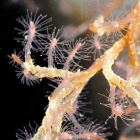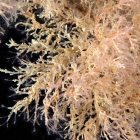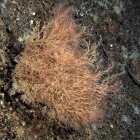WoRMS taxon details
Corydendrium Van Beneden, 1844
117052 (urn:lsid:marinespecies.org:taxname:117052)
accepted
Genus
Soleniopsis Ritchie, 1907 · unaccepted (synonym)
- Species Corydendrium album Hirohito, 1988
- Species Corydendrium brevicaulis Hirohito, 1988
- Species Corydendrium dispar Kramp, 1935
- Species Corydendrium flabellatum Fraser, 1938
- Species Corydendrium fruticosum Fraser, 1914
- Species Corydendrium parasiticum (Linnaeus, 1767)
- Species Corydendrium dendriformis (Ritchie, 1907) accepted as Corydendrium parasiticum (Linnaeus, 1767) (synonym)
- Species Corydendrium minor Nutting, 1906 accepted as Turritopsis minor (Nutting, 1906) (basionym)
- Species Corydendrium nutricula (McCrady, 1857) accepted as Turritopsis nutricula McCrady, 1857 (unaccepted combination)
- Species Corydendrium sessile Ritchie, 1910 accepted as Corydendrium parasiticum (Linnaeus, 1767) (questionable synonym)
- Species Corydendrium splendidum Boone, 1938 accepted as Pennaria disticha Goldfuss, 1820 (unaccepted > junior subjective synonym)
- Species Corydendrium zelandicum Stechow, 1924 accepted as Turritopsis rubra (Farquhar, 1895) (unaccepted > junior objective synonym)
- Species Corydendrium corrugatum Nutting, 1906 (uncertain > taxon inquirendum)
marine, fresh, terrestrial
recent only
Beneden, P.J. van. (1844). Sur les genres Eleutherie et Synhydre. <em>Bulletins de l'Académie Royale des Sciences et Belles-Lettres de Bruxelles.</em> 11: 305-314., available online at https://www.biodiversitylibrary.org/page/15742170
page(s): 313 [details]
page(s): 313 [details]
Schuchert, P.; Choong, H.; Galea, H.; Hoeksema, B.; Lindsay, D.; Manko, M.; Pica, D. (2025). World Hydrozoa Database. Corydendrium Van Beneden, 1844. Accessed through: World Register of Marine Species at: https://www.marinespecies.org/aphia.php?p=taxdetails&id=117052 on 2025-04-06
Date
action
by
2006-09-08 06:50:23Z
changed
Martinez, Olga
![]() The webpage text is licensed under a Creative Commons
Attribution 4.0 License
The webpage text is licensed under a Creative Commons
Attribution 4.0 License
Nomenclature
original description
Beneden, P.J. van. (1844). Sur les genres Eleutherie et Synhydre. <em>Bulletins de l'Académie Royale des Sciences et Belles-Lettres de Bruxelles.</em> 11: 305-314., available online at https://www.biodiversitylibrary.org/page/15742170
page(s): 313 [details]
original description (of Soleniopsis Ritchie, 1907) Ritchie, J. 1907a. On collections of the Cape Verde Island marine fauna, made by Cyril Crossland, M. A. (Cantab.), B.Sc. (Lond.), F.Z.S., of St. Andrews University, July to September, 1904. Proceedings of the Zoological Society of London 1907: 488-514,pls 23-26., available online at https://biodiversitylibrary.org/page/31578870
page(s): 494 [details]
basis of record van der Land, J.; Vervoort, W.; Cairns, S.D.; Schuchert, P. (2001). Hydrozoa, <B><I>in</I></B>: Costello, M.J. <i>et al.</i> (Ed.) (2001). <i>European register of marine species: a check-list of the marine species in Europe and a bibliography of guides to their identification. Collection Patrimoines Naturels,</i> 50: pp. 112-120 (look up in IMIS) [details]
page(s): 313 [details]
original description (of Soleniopsis Ritchie, 1907) Ritchie, J. 1907a. On collections of the Cape Verde Island marine fauna, made by Cyril Crossland, M. A. (Cantab.), B.Sc. (Lond.), F.Z.S., of St. Andrews University, July to September, 1904. Proceedings of the Zoological Society of London 1907: 488-514,pls 23-26., available online at https://biodiversitylibrary.org/page/31578870
page(s): 494 [details]
basis of record van der Land, J.; Vervoort, W.; Cairns, S.D.; Schuchert, P. (2001). Hydrozoa, <B><I>in</I></B>: Costello, M.J. <i>et al.</i> (Ed.) (2001). <i>European register of marine species: a check-list of the marine species in Europe and a bibliography of guides to their identification. Collection Patrimoines Naturels,</i> 50: pp. 112-120 (look up in IMIS) [details]
Taxonomy
redescription
Schuchert, P. (2004). Revision of the European athecate hydroids and their medusae (Hydrozoa, Cnidaria): families Oceanidae and Pachycordylidae. <em>Revue Suisse de Zoologie.</em> 111 2: 315-369.
page(s): 335 [details]
page(s): 335 [details]
Other
context source (Hexacorallia)
Fautin, Daphne G. (2013). Hexacorallians of the World. (look up in IMIS) [details]
additional source Neave, Sheffield Airey. (1939-1996). Nomenclator Zoologicus vol. 1-10 Online. <em>[Online Nomenclator Zoologicus at Checklistbank. Ubio link has gone].</em> , available online at https://www.checklistbank.org/dataset/126539/about [details]
additional source Costello, M.J., C. Emblow & R. White (EdS.). (2001). European register of marine species: a check-list of the marine species in Europe and a bibliography of guides to their identification. <em>Collection Patrimoines Naturels, 50. Muséum national d'Histoire Naturelle: Paris, France.</em> 463 pp. (look up in IMIS) [details]
additional source Boero, Ferdinando (look up in IMIS) [details]
additional source Neave, Sheffield Airey. (1939-1996). Nomenclator Zoologicus vol. 1-10 Online. <em>[Online Nomenclator Zoologicus at Checklistbank. Ubio link has gone].</em> , available online at https://www.checklistbank.org/dataset/126539/about [details]
additional source Costello, M.J., C. Emblow & R. White (EdS.). (2001). European register of marine species: a check-list of the marine species in Europe and a bibliography of guides to their identification. <em>Collection Patrimoines Naturels, 50. Muséum national d'Histoire Naturelle: Paris, France.</em> 463 pp. (look up in IMIS) [details]
additional source Boero, Ferdinando (look up in IMIS) [details]
 Present
Present  Inaccurate
Inaccurate  Introduced: alien
Introduced: alien  Containing type locality
Containing type locality
From editor or global species database
Diagnosis Erect, branching or stolonal hydroid colonies, monosiphonic or polysiphonic. In branching colonies, branches and hydranth pedicels adnate to other branches over part or almost all their length. Perisarc firm, terminating near hydranth base, tubes of sister-branches nested. Hydranths spindle- to club-shaped; filiform tentacles scattered over much of hydranth body. Gonads formed within perisarc tubes of branchlets or at the end of branchlets and thus eplacing a hydranth. Gonads gastrodermal. [details]



